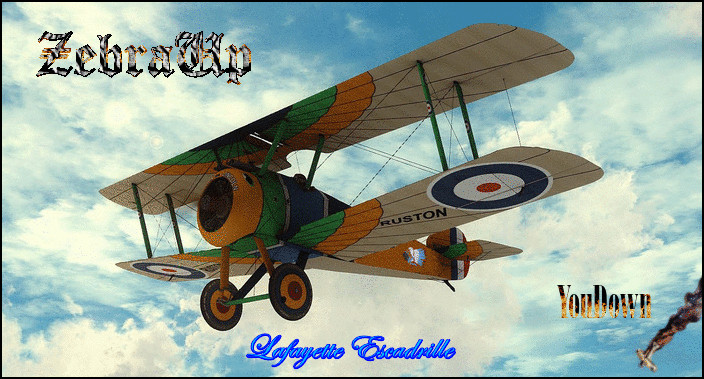For those of you interested in history and wanting to know what life was like for a pilot during the Great War, read this article written by a pilot who was living it daily.. a pilot of the Lafayette Escadrille
www.worldwar1.com/heritage/le_verdun.htm
Here is an excerpt from it:
Our daily routine goes on with little change. Whenever the weather permits - that is, when it isn't raining, and the clouds aren't too low - we fly over the Verdun battlefield at the hours dictated by General Headquarters. As a rule the most successful sorties are those in the early morning.
We are called while it's still dark Sleepily I try to reconcile the French orderly's muttered, C'est l'heure, monsieur, that rouses me from slumber, with the strictly American words and music of "When That Midnight Choo Choo Leaves for Alabam'" warbled by a particularly wide-awake pilot in the next room. A few minutes later, having swallowed some coffee, we motor to the field. The east is turning gray as the hangar curtains are drawn apart and our machines trundled out by the mechanics. All the pilots whose planes are in commission, save those remaining behind on guard - prepare to leave. We average from four to six on a sortie, unless too many flights have been ordered for that day, in which case only two or three go out at a time.
Now the east is pink, and overhead the sky has changed from gray to pale blue. It is light enough to fly. We don our fur-lined shoes and combinations, and adjust the leather flying hoods and goggles. A good deal of conversation occurs - perhaps because, once aloft, there's nobody to talk to.
"Eh, you," one pilot cries jokingly to another, "I hope some Boche just ruins you this morning, so I won't have to pay you the fifty francs you won from me last night!"
This financial reference concerns a poker game.
"You do, do you?" replies the other as he swings into his machine. "Well, I'd be glad to pass up the fifty to see you landed by the Boches. You'd make a fine sight walking down the street of some German town in those wooden shoes and pajama pants. Why don't you dress yourself? Don't you know an aviator's supposed to look chic?"
A sartorial eccentricity on the part of one of our colleagues is here referred to.
The raillery is silenced by a deafening roar as the motors are tested. Quiet is briefly restored, only to be broken by a series of rapid explosions incidental to the trying out of machine guns. You loudly inquire at what altitude we are to meet above the field.
"Fifteen hundred meters - go ahead!" comes an answering yell.
"Essence et gaz! [Oil and gas!]" you call to your mechanic, adjusting your gasoline and air throttles while he grips the propeller.
"Contact!" he shrieks, and "Contact!" you reply. You snap on the switch, he spins the propeller, and the motor takes. Drawing forward out of line, you put on full power, race across the grass and take the air. The ground drops as the hood slants up before you and you seem to be going more and more slowly as you rise. At a great height you hardly realize you are moving. You glance at the clock to note the time of your departure, and at the oil gauge to see its throb. The altimeter registers 650 feet. You turn and look back at the field below and see others leaving.
In three minutes you are at about 4,000 feet. You have been making wide circles over the field and watching the other machines. At 4,500 feet you throttle down and wait on that level for your companions to catch up. Soon the escadrille is bunched and off for the lines. You begin climbing again, gulping to clear your ears in the changing pressure. Surveying the other machines, you recognize the pilot of each by the marks on its side - or by the way he flies. The distinguishing marks of the Nieuports are various and sometimes amusing. Bert Hall, for instance, has Bert painted on the left side of his plane and the same word reversed (as if spelled backward with the left hand) on the right - so an aviator passing him on that side at great speed will be able to read the name without difficulty, he says!
The country below has changed into a flat surface of varicolored figures. Woods are irregular blocks of dark green, like daubs of ink spilled on a table; fields are geometrical designs of different shades of green and brown, forming in composite an ultra-cubist painting; roads are thin white lines, each with its distinctive windings and crossings - from which you determine your location. The higher you are the easier it is to read.
In about ten minutes you see the Meuse sparkling in the morning light, and on either side the long line of sausage-shaped observation balloons far below you. Red-roofed Verdun springs into view just beyond. There are spots in it where no red shows and you know what has happened there. In the green pasture land bordering the town, round flecks of brown indicate the shell holes. You cross the Meuse.
Immediately east and north of Verdun there lies a broad, brown band. From the Woevre plain it runs westward to the "S" bend in the Meuse, and on the left bank of that famous stream continues on into the Argonne Forest. Peaceful fields and farms and villages adorned that landscape a few months ago - when there was no Battle of Verdun. Now there is only that sinister brown belt, a strip of murdered Nature. It seems to belong to another world. Every sign of humanity has been swept away. The woods and roads have vanished like chalk wiped from a blackboard; of the villages nothing remains but gray smears where stonewalls have tumbled together. The great forts of Douaumont and Vaux are outlined faintly, like the tracings of a finger in wet sand. One cannot distinguish any one shell crater, as one can on the pockmarked fields on either side. On the brown band the indentations are so closely interlocked that they blend into a confused mass of troubled earth. Of the trenches only broken, half-obliterated links are visible.
Columns of muddy smoke spurt up continually as high explosives tear deeper into this ulcered area. During heavy bombardment and attacks I have seen shells falling like rain. The countless towers of smoke remind one of Gustave Doré's picture of the fiery tombs of the arch-heretics in Dante's "Hell." A smoky pall covers the sector under fire, rising so high that at a height of 1,000 feet one is enveloped in its mist-like fumes. Now and then monster projectiles, hurtling through the air close by, leave one's plane rocking violently in their wake. Airplanes have been cut in two by them.
For us the battle passes in silence, the noise of one's motor deadening all other sounds. In the green patches behind the brown belt myriads of tiny flashes tell where the guns are hidden; and those flashes, and the smoke of bursting shells, are all we see of the fighting. It is a weird combination of stillness and havoc, the Verdun conflict viewed from the sky.
Far below us, the observation and range-finding planes circle over the trenches like gliding gulls. At a feeble altitude they follow the attacking infantrymen and flash back wireless reports of the engagement. Only through them can communication be maintained when, under the barrier fire, wires from the front lines are cut. Sometimes it falls to our lot to guard these machines from Germans eager to swoop down on their backs. Sailing about high above a busy flock of them makes one feel like an old mother hen protecting her chicks.
Getting started is the hardest part of an attack. Once you have begun diving you're all right. The pilot just ahead turns tail up like a trout dropping back to water, and swoops down in irregular curves and circles. You follow at an angle so steep your feet seem to be holding you back in your seat. Now the black Maltese crosses on the German's wings stand out clearly. You think of him as some sort of big bug. Then you hear the rapid tut-tut-tut of his machine gun. The man that dived ahead of you becomes mixed up with the topmost German. He is so close it looks as if he had hit the enemy machine. You hear the staccato barking of his mitrailleuse and see him pass from under the German's tail.
The rattle of the gun that is aimed at you leaves you undisturbed. Only when the bullets pierce the wings a few feet off do you become uncomfortable. You see the gunner crouched down behind his weapon, but you aim at where the pilot ought to be - there are two men aboard the German craft - and press on the release hard. Your mitrailleuse hammers out a stream of bullets as you pass over and dive, nose down, to get out of range. Then, hopefully, you re-dress and look back at the foe. He ought to be dropping earthward at several miles a minute. As a matter of fact, however, he is sailing serenely on. They have an annoying habit of doing that, these Boches.






